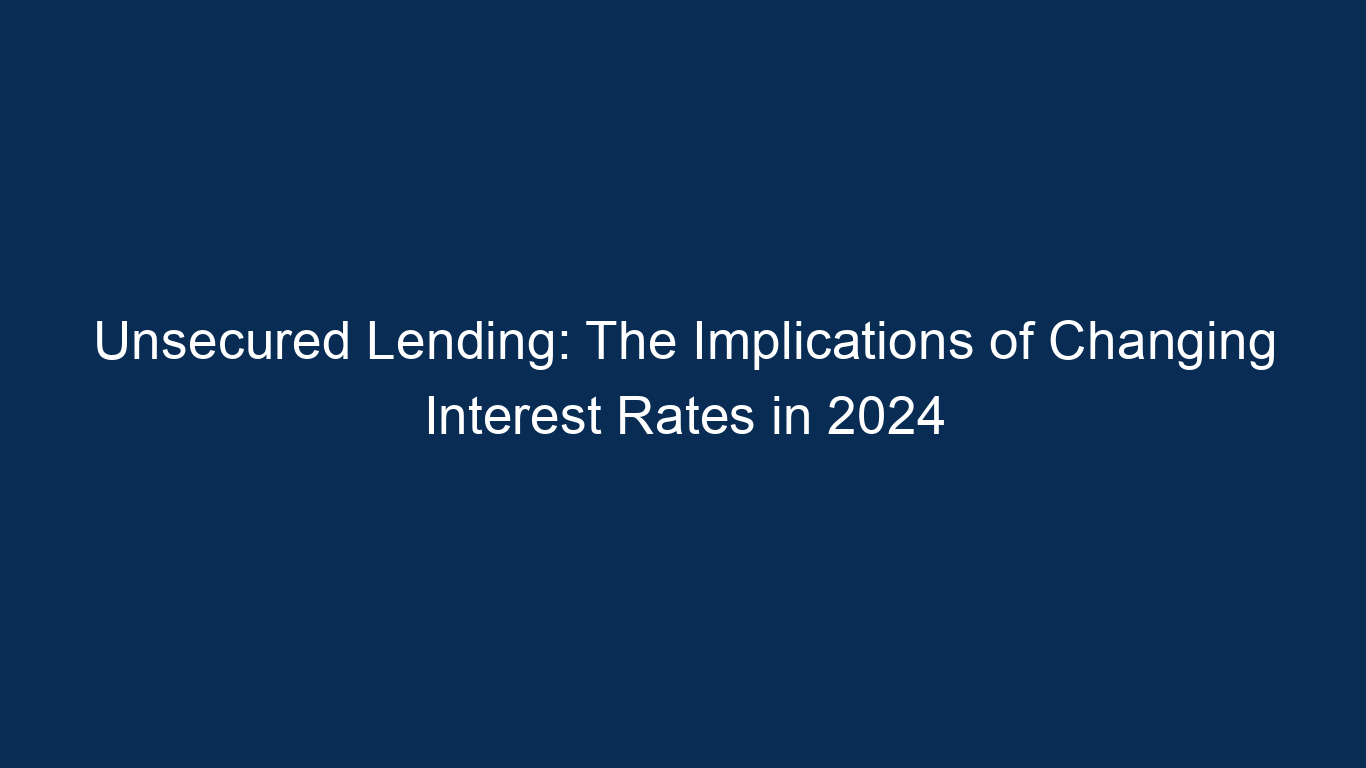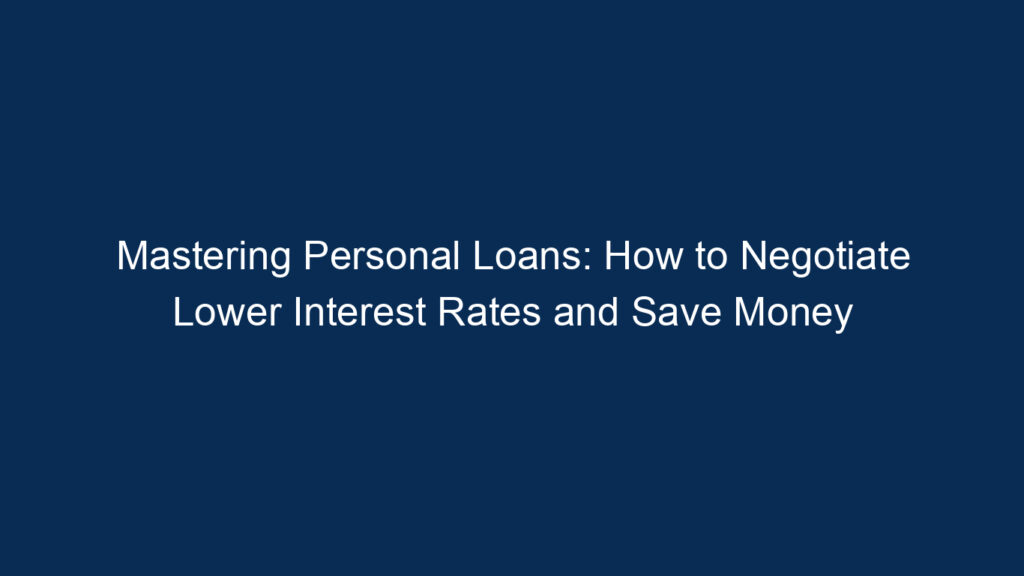In the world of finance, interest rates play a crucial role in shaping the lending landscape. They have the power to influence borrowing costs, investment decisions, and overall economic growth. As we look ahead to the year 2024, it is essential to understand the implications that changing interest rates may have on unsecured lending.
Unsecured lending refers to loans that are not backed by collateral, such as personal loans, credit cards, and lines of credit. These types of loans are granted based on the borrower’s creditworthiness and are typically associated with higher interest rates compared to secured loans. In a changing interest rate environment, unsecured lending can be particularly affected, as it is more susceptible to fluctuations in borrowing costs.
The year 2024 is projected to witness potential shifts in interest rates due to several factors, including global economic conditions, monetary policy decisions by central banks, and inflationary pressures. These changes can have both positive and negative implications for unsecured lending.
On one hand, a decline in interest rates can make borrowing more affordable, stimulating demand for unsecured loans. Lower interest rates can incentivize consumers to take on more debt, leading to increased spending, investment, and economic growth. This can be particularly beneficial for individuals seeking personal loans or credit cards to finance major purchases or cover unexpected expenses.
On the other hand, rising interest rates can impact unsecured lending negatively. An increase in borrowing costs can deter individuals from taking on additional debt, thereby reducing demand for unsecured loans. Higher interest rates may also lead to increased default rates, as borrowers struggle to meet their repayment obligations. This can have a ripple effect on the financial system, potentially impacting lenders and investors.
Moreover, changing interest rates can also affect the profitability and risk appetite of financial institutions. Banks and other lenders may find it challenging to manage their portfolios and balance the trade-off between attracting borrowers and maintaining profitability in a changing rate environment. This can result in tighter lending standards, making it more difficult for some individuals to access unsecured credit.
In conclusion, the implications of changing interest rates in 2024 on unsecured lending are multifaceted. While lower rates can stimulate borrowing and economic activity, higher rates can restrict access to credit and increase default risks. Financial institutions must carefully navigate these dynamics, and borrowers should be aware of the potential impact on their borrowing costs and repayment obligations. As we progress into 2024, monitoring interest rate trends will be crucial for understanding the evolving landscape of unsecured lending.
Table of Contents
- “Navigating the Unsecured Lending Landscape: Anticipating the Impact of Changing Interest Rates in 2024”
- “Preparing for the Unpredictable: How Changing Interest Rates in 2024 Could Affect Unsecured Lending”
- “Unsecured Lending in 2024: Exploring the Potential Consequences of Fluctuating Interest Rates”
- “Interest Rate Volatility and Unsecured Lending: Understanding the Challenges Ahead in 2024”
“Navigating the Unsecured Lending Landscape: Anticipating the Impact of Changing Interest Rates in 2024”
In today’s ever-changing financial landscape, it is crucial for both individuals and businesses to stay informed about the potential impact of changing interest rates. As we move towards the year 2024, it becomes even more important to anticipate and understand the implications that these shifts may have on unsecured lending.
Unsecured lending refers to loans that are not backed by collateral, such as personal loans or credit card debt. Unlike secured loans, which are backed by assets like real estate or vehicles, unsecured loans rely solely on the borrower’s creditworthiness. Therefore, any changes in interest rates can have a significant impact on both lenders and borrowers alike.
Interest rates play a key role in determining the cost of borrowing. When interest rates rise, the cost of borrowing increases, making it more expensive for individuals and businesses to take out unsecured loans. This can result in a decrease in loan demand, as borrowers may find it less affordable to access credit.
Additionally, rising interest rates can also lead to higher monthly payments for existing borrowers. This can put a strain on individuals’ financial budgets and potentially lead to missed payments or even defaults on loans. Lenders, on the other hand, may experience an increase in delinquencies and defaults, which can negatively impact their profitability.
Conversely, when interest rates decrease, the cost of borrowing becomes more affordable. This can stimulate loan demand, as individuals and businesses are more likely to take advantage of lower interest rates to access credit. Lower rates can also result in lower monthly payments for existing borrowers, freeing up more disposable income and potentially improving their ability to repay their loans.
It is important to note that predicting the exact trajectory of interest rates is inherently challenging. Many factors, such as inflation, monetary policy decisions, and economic indicators, can influence interest rate movements. However, staying informed about market trends and economic forecasts can provide valuable insights into potential changes in interest rates.
In conclusion, as we approach 2024, individuals and businesses should be mindful of the potential impact of changing interest rates on unsecured lending. By understanding how interest rate fluctuations can affect borrowing costs and loan demand, borrowers can make informed decisions about their credit needs. Likewise, lenders can prepare for potential shifts in delinquencies and defaults, ensuring they are well-equipped to mitigate any adverse effects. In this complex and dynamic lending landscape, knowledge and foresight are key to navigating the unsecured lending landscape successfully.
“Preparing for the Unpredictable: How Changing Interest Rates in 2024 Could Affect Unsecured Lending”
Preparing for the Unpredictable: How Changing Interest Rates in 2024 Could Affect Unsecured Lending
Introduction
In the ever-changing landscape of the financial markets, it is crucial for lenders to stay ahead of the curve and anticipate potential shifts that could impact their lending practices. One such factor that demands careful attention is the fluctuation of interest rates. As we approach the year 2024, experts are predicting possible changes in interest rates, which could have far-reaching consequences for unsecured lending. This article aims to shed light on the potential effects of changing interest rates on unsecured lending and offers insights into how lenders can prepare for the unpredictable.
Understanding Unsecured Lending
Before delving into the impact of changing interest rates, it is essential to grasp the concept of unsecured lending. Unlike secured loans, which are backed by collateral such as real estate or vehicles, unsecured loans are granted solely based on the borrower’s creditworthiness. These loans often come with higher interest rates, reflecting the increased risk for lenders due to the absence of collateral.
The Potential Impact of Changing Interest Rates
- Borrowing Costs: One of the most immediate effects of rising interest rates is an increase in borrowing costs. As lenders adjust their rates to reflect the higher cost of capital, borrowers will face higher interest payments on their unsecured loans. This could lead to decreased demand for unsecured lending, as borrowers may opt for more affordable alternatives or delay their borrowing decisions.
- Creditworthiness Assessment: As interest rates change, lenders may become more stringent in assessing the creditworthiness of potential borrowers. Higher interest rates increase the risk of default, prompting lenders to scrutinize credit histories and financial profiles more thoroughly. This could result in stricter lending criteria and a decrease in the number of approved unsecured loans. Borrowers with marginal credit scores may find it increasingly difficult to secure unsecured loans.
- Loan Portfolio Performance: Changing interest rates can significantly impact the performance of a lender’s loan portfolio. As interest rates rise, borrowers with existing unsecured loans may struggle to meet their increased monthly payments, leading to higher default rates. This could result in increased losses for lenders and a need to adjust risk management strategies to mitigate the potential impact on their portfolios.
Preparing for the Unpredictable
Given the potential impact of changing interest rates on unsecured lending, lenders must take proactive steps to prepare for the unpredictable. Here are a few strategies to consider:
- Stress Testing: Conducting stress tests on loan portfolios can help lenders assess the potential impact of changing interest rates. By simulating various interest rate scenarios, lenders can identify vulnerabilities and develop contingency plans to minimize potential losses.
- Diversification: Lenders should consider diversifying their lending portfolios to mitigate the impact of changing interest rates. By offering a mix of secured and unsecured loans, lenders can balance the risk and ensure a stable revenue stream even during uncertain times.
- Risk Management: Strengthening risk management practices is crucial in a changing interest rate environment. Lenders should regularly review their credit assessment methodologies, monitor borrower creditworthiness, and adjust underwriting criteria accordingly. This proactive approach can help minimize default risk and ensure the long-term stability of the lending business.
Conclusion
As the year 2024 approaches, the possibility of changing interest rates looms over the lending industry. Lenders must be prepared for the potential impact on unsecured lending, including increased borrowing costs, stricter creditworthiness assessments, and potential loan portfolio
“Unsecured Lending in 2024: Exploring the Potential Consequences of Fluctuating Interest Rates”
Unsecured Lending in 2024: Exploring the Potential Consequences of Fluctuating Interest Rates
Introduction:
This article aims to delve into the potential consequences of fluctuating interest rates on unsecured lending in the year
- By examining the implications of such fluctuations, we seek to provide valuable insights for both lenders and borrowers, enabling them to make informed decisions in an ever-changing economic landscape. The analysis will adopt an informative writing style and maintain a formal tone to ensure clarity and credibility.
Body:
- Definition of unsecured lending:
To establish a common understanding, unsecured lending refers to the practice of granting loans without requiring any collateral or assets as security. These loans are primarily based on the borrower’s creditworthiness and ability to repay the borrowed amount. Unsecured lending encompasses various forms, including personal loans, credit cards, and lines of credit.
- The impact of fluctuating interest rates on borrowers:
a) Increased borrowing costs:
When interest rates rise, borrowers will face higher borrowing costs, as the interest charged on unsecured loans will also increase. This can result in reduced affordability and potentially limit borrowing capacity for individuals and businesses alike.b) Debt burden escalation:
Fluctuating interest rates may lead to an increase in the debt burden for borrowers with existing unsecured loans. As interest rates rise, monthly repayments are likely to increase, placing a strain on borrowers’ financial situations. This can potentially lead to defaults and financial distress for those with limited disposable income.c) Altered borrowing behavior:
Unsecured lending is highly sensitive to interest rate fluctuations. As rates rise, borrowers may become more cautious and opt for alternative financing options or postpone their borrowing decisions. Consequently, lenders may experience decreased demand for unsecured loans, affecting their profitability and growth prospects. - The impact of fluctuating interest rates on lenders:
a) Profitability challenges:
Lenders extending unsecured loans may face profitability challenges when interest rates fluctuate. Higher interest rates can result in reduced demand, as borrowers seek more affordable options. This can lead to decreased loan origination, impacting the lender’s revenue and overall profitability.b) Increased default risks:
Fluctuating interest rates can also increase the default risks for lenders. As borrowers face higher borrowing costs, the likelihood of repayment difficulties and defaults may rise. Lenders must carefully assess the creditworthiness of borrowers and adjust lending criteria to mitigate potential losses.c) Risk management considerations:
Lenders need to implement robust risk management strategies to navigate the impact of fluctuating interest rates. This includes monitoring market conditions, stress testing loan portfolios, and employing effective risk mitigation measures. Such measures are crucial to ensure the lender’s stability and resilience in the face of economic uncertainties.Conclusion:
In conclusion, the potential consequences of fluctuating interest rates on unsecured lending in 2024 are multifaceted. Borrowers may face increased borrowing costs, escalated debt burdens, and altered borrowing behavior. Lenders, on the other hand, may encounter profitability challenges, heightened default risks, and the need for rigorous risk management. By understanding these potential consequences, both lenders and borrowers can navigate the changing economic environment more effectively, making informed decisions that align with their financial goals and requirements.
“Interest Rate Volatility and Unsecured Lending: Understanding the Challenges Ahead in 2024”
In the world of finance, one of the key factors that can greatly impact lending practices is interest rate volatility. As we look ahead to the year 2024, it is crucial for lenders to understand the challenges that lie ahead in unsecured lending due to this volatility. In this article, we will delve into the intricacies of interest rate volatility and its implications for unsecured lending, providing a comprehensive understanding of the potential obstacles that lenders may face.
First and foremost, it is essential to grasp the concept of interest rate volatility. Interest rates are determined by various economic factors, such as inflation, monetary policy, and market conditions. Volatility refers to the degree of fluctuation in these interest rates over a given period. When interest rates experience high levels of volatility, lenders face increased uncertainty and risk in determining appropriate lending rates for unsecured loans.
Unsecured lending, as the name suggests, involves providing loans without any collateral or security. This type of lending is widely prevalent in various sectors, including personal loans, credit card debt, and small business financing. However, the absence of collateral inherently increases the risk for lenders, as they have no assets to seize in the event of default. Consequently, interest rates play a crucial role in compensating for this risk in unsecured lending.
Interest rate volatility poses significant challenges for lenders in unsecured lending. Fluctuating interest rates make it difficult for lenders to accurately assess the risk associated with unsecured loans. This uncertainty often leads to higher interest rates being charged to borrowers, as lenders attempt to mitigate potential losses. Consequently, borrowers may be deterred from seeking unsecured loans due to the higher cost of borrowing, thus impacting the demand for such lending products.
Moreover, interest rate volatility can also affect the profitability of lenders. Lenders typically rely on the spread between the interest rates charged on loans and the interest rates they pay on their own borrowings to generate income. However, when interest rates become volatile, this spread can narrow, reducing the profitability of unsecured lending. Lenders must carefully manage their interest rate risk to ensure their financial stability and sustainability in the face of these challenges.
To address the challenges posed by interest rate volatility in unsecured lending, lenders must adopt robust risk management strategies. This involves closely monitoring market conditions and economic indicators to gauge potential changes in interest rates. Lenders should also employ sophisticated models and risk assessment tools to accurately estimate the appropriate interest rates for unsecured loans. By staying informed and proactive, lenders can navigate the uncertainties of interest rate volatility and maintain a competitive edge in the unsecured lending market.
In conclusion, interest rate volatility presents significant challenges for lenders in unsecured lending. The fluctuation in interest rates creates uncertainty, making risk assessment and pricing of unsecured loans more challenging. Additionally, lenders may face lower profitability due to the narrowing of interest rate spreads. To overcome these obstacles, lenders must adopt effective risk management strategies and remain vigilant in monitoring market conditions. By doing so, lenders can navigate the challenges ahead in 2024 and continue to provide valuable unsecured lending options to borrowers.
In conclusion, the implications of changing interest rates in 2024 on unsecured lending are likely to have a significant impact on borrowers and lenders alike. With interest rates expected to rise, borrowers may face higher costs and reduced affordability when seeking unsecured loans. This could lead to a decrease in consumer spending and economic activity. On the other hand, lenders may benefit from higher interest rates as they can charge more for their services. However, they must also be cautious about potential defaults and delinquencies as borrowers may struggle to meet their increased repayment obligations. Overall, the changing interest rates in 2024 will require both borrowers and lenders to carefully assess their financial positions and adjust their strategies accordingly to navigate the evolving lending landscape.






